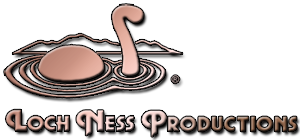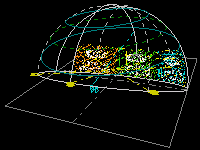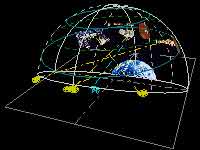| In the production studio: Computer with CD-ROM drive Image processing software Output device |
| In the theater 1. At least three screens of slide projectors in L-C-R array |
| 2. Horizon panorama or all-sky projector system |
| 3. A capable planetarium projector with planets and annual motion |
| Recommended: Zoom-slew Ripple-wheel FX projector |
| NOT used: Video |
More Than Meets The Eye Equipment Requirements
With only 83 images to show during its half-hour duration, More Than Meets The Eye is not a visually complex show. Even a minimally-equipped planetarium theater should be able to program a professional presentation. We've provided this page to help you determine if your planetarium has the necessary equipment to present More Than Meets The Eye.
The show soundtrack is recorded on CD, so you'll need a CD player to play the disc, even if it's just to copy the audio to another medium, such as multi-track tape or hard drive.
The show's still images are recorded on data CD, so you'll need the resources (computer, image processing software, output devices) to transform the digital images into whatever form your theater uses to project. For classic (slide-projector-based) planetaria, that will mean making 35mm slides.
1. At least three screens (preferably dissolving) of slide projectors in Left-Center-Right array
This is a screen format familiar to long-time Loch Ness Productions customers.
Many of the scenes in our shows are illustrated with three images, which are introduced in sequential order: Left, then Center, then Right. After all three are up, they often "wipe" off in the same order.
In More Than Meets The Eye, we continually compare and contrast objects seen through binoculars, larger telescopes, and observatory views, so the ability to show them side-by-side is essential.
For this show, the screens don't necessarily have to be dissolvers, but for timing, there are instances in which dissolve pairs may come in handy.
2. Horizon panorama or all-sky projector system
There is only 1 multi-panel image in the show, a generic "backyard", which sets a scene of familiarity at the show's opening and closing. If your planetarium already has a local landscape installed, you're welcome to use it instead.
To use our backyard pan in slide form, you'll need that calibrated set of projectors which project on the horizon, commonly known as a panorama system.
In the digital age, what may be a 3-panel pan in one theater may be a 2- or 4-panel pan in another, or a pan can be remapped to an all-sky. As you know, individual slide frames are in a 3:2 ratio. The backyard image in the show is in a 9:2 format ratio — what might otherwise be called a "3-panel partial pan" — intended to span approximately 90 degrees on the horizon.
This is in addition to the main screens, which project up in the sky, of course.
Using a dedicated projector with a wide-angle or anamorphic lens to stretch the backyard image can work too.
3. A capable planetarium projector with planets, diurnal and annual motion
More Than Meets The Eye features the planetarium star projector prominently.
We point out the Moon, and all four commonly-visible planets (with Mars moving in annual motion).
We roll from winter to spring to summer during the show, and point out deep-sky objects — that need to be there! Please be sure your star projector actually projects all the objects in our list, otherwise you're going to look pretty foolish pointing out non-existent objects in the sky!
Recommended: Zoom-slew, Ripple-wheel FX projector
While non-moving slides can illustrate the scenes, the show will benefit from having spacecraft flying by Mars, Hubble drifting slowly in Earth orbit, etc.
To simulate atmospheric distortion in a telescopic view, many planetarians use a motorized "ripple-wheel" FX projector that places a warped glass or plastic disc in front of the slide projector lens, causing the image to waver on the dome. In lieu of having such capability, you could let people use their imaginations while the narrator describes the phenomenon, but it really would look much better if they audience could see it with their own eyes.
NOT used: Video
We use no moving video with the show, intentionally. This is a program designed for the pacing of still imagery. The visual style of the show is non-dynamic slides. To have inserted just one or two video clips would have been very jarring and out-of-context with the remainder of the show. In other words, why would there be only one or two scenes that feature full motion animation, when the rest of the show doesn't have any?







